Risk Management Plan Report: NatureCare Products Expansion Project
VerifiedAdded on 2022/03/28
|21
|4195
|227
Report
AI Summary
This report presents a comprehensive risk management plan for NatureCare Products' project of opening new retail outlets in central Melbourne and Sydney. It begins with an introduction to risk management, defining risk and its importance in project implementation. The report addresses risk identification techniques, including brainstorming, root cause analysis, and SWOT analysis, and details sources of information such as self-inspection and issue logs. It outlines key components of a risk management plan, such as roles and responsibilities, budget, and risk registers, and summarizes the Australian/New Zealand standard for risk management. The report then delves into qualitative and quantitative risk analysis, the risk management process, and risk controlling options like elimination and substitution. Task 2 focuses on the specific project for NatureCare Products, detailing risk objectives, standards, and identification methods. The report also includes a risk register, risk assessment processes, and the context of the project, analyzing potential human resource-related risks using brainstorming, SWOT analysis, and interviewing methods.
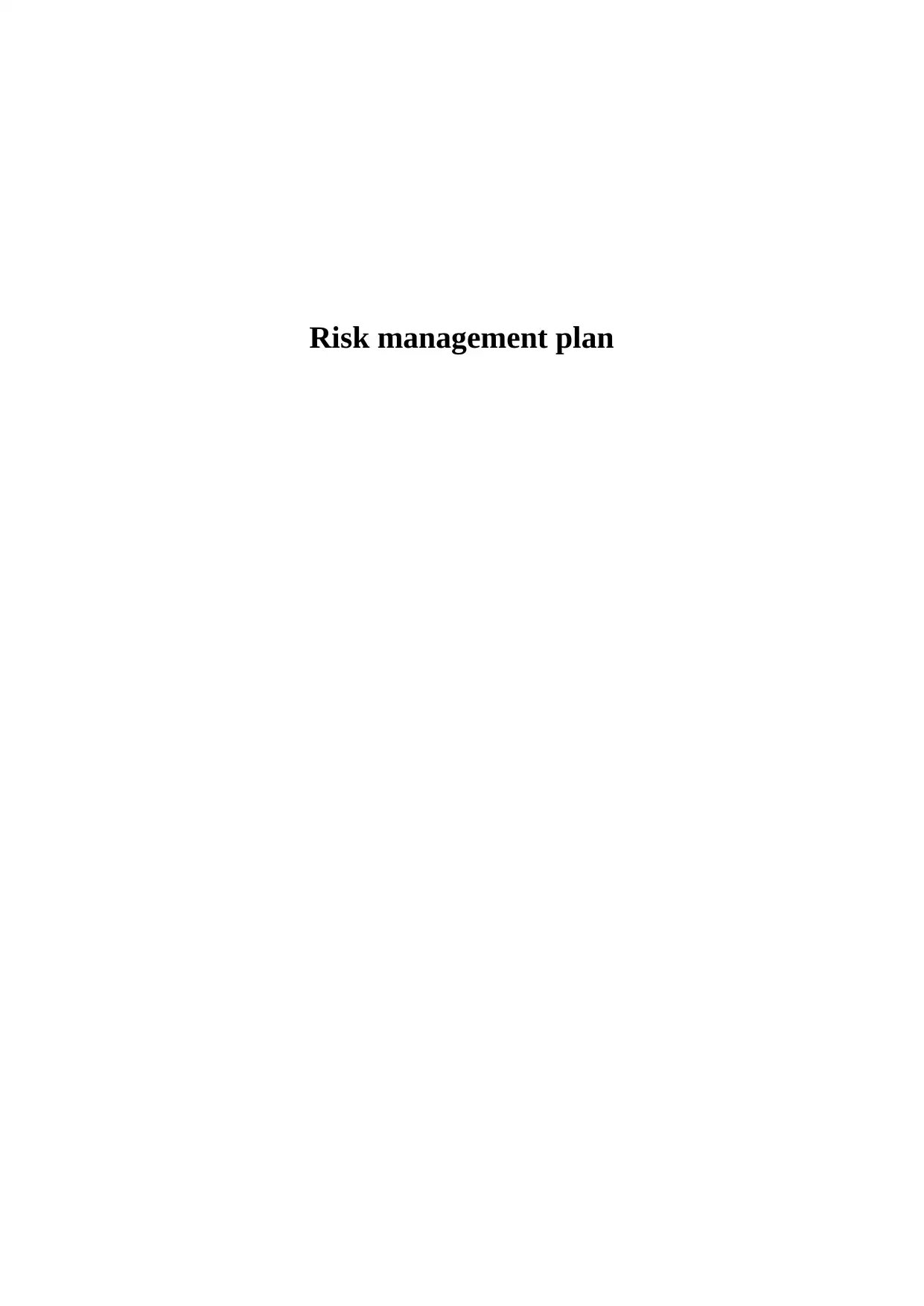
Risk management plan
Paraphrase This Document
Need a fresh take? Get an instant paraphrase of this document with our AI Paraphraser
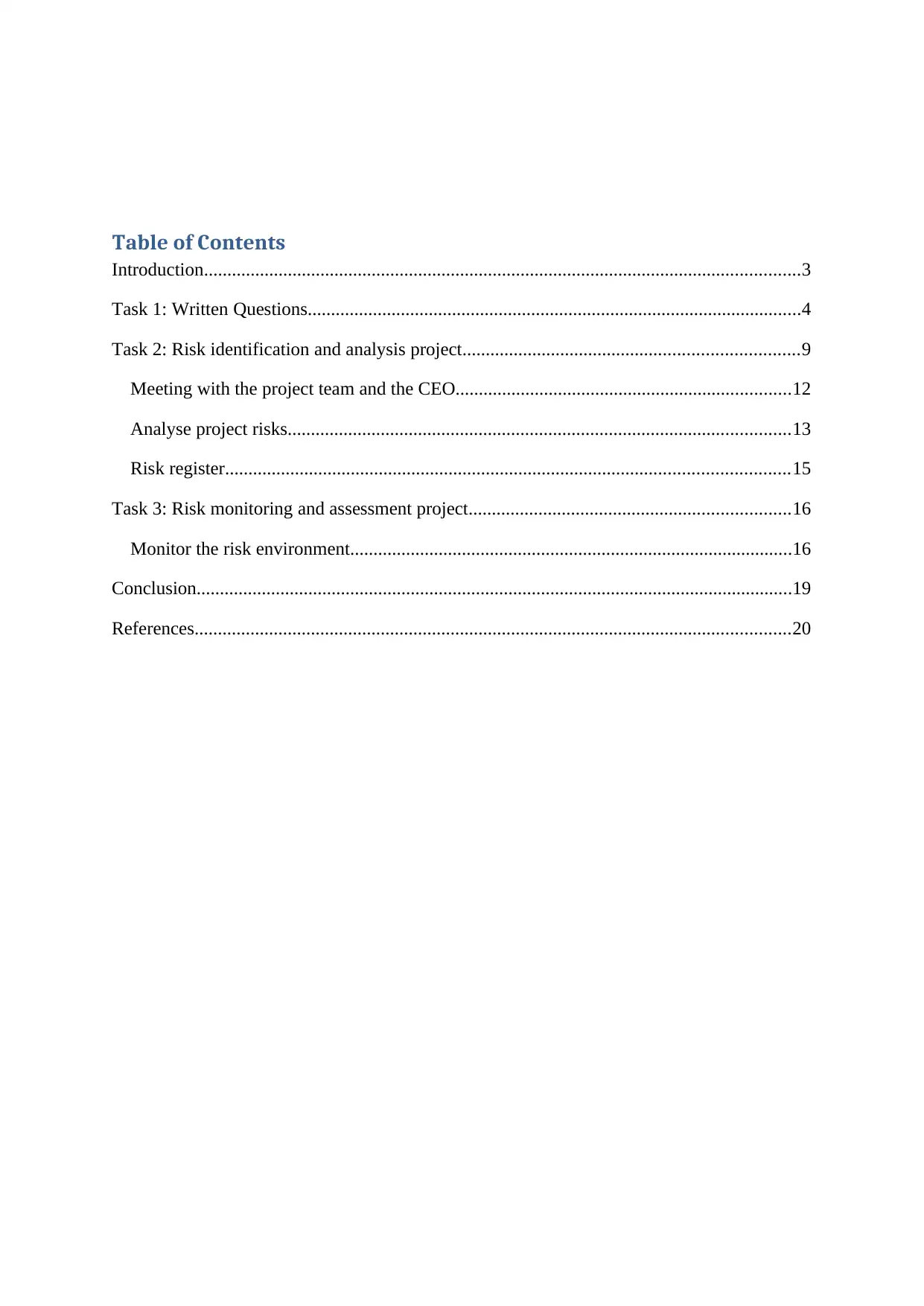
Table of Contents
Introduction................................................................................................................................3
Task 1: Written Questions..........................................................................................................4
Task 2: Risk identification and analysis project........................................................................9
Meeting with the project team and the CEO........................................................................12
Analyse project risks............................................................................................................13
Risk register.........................................................................................................................15
Task 3: Risk monitoring and assessment project.....................................................................16
Monitor the risk environment...............................................................................................16
Conclusion................................................................................................................................19
References................................................................................................................................20
Introduction................................................................................................................................3
Task 1: Written Questions..........................................................................................................4
Task 2: Risk identification and analysis project........................................................................9
Meeting with the project team and the CEO........................................................................12
Analyse project risks............................................................................................................13
Risk register.........................................................................................................................15
Task 3: Risk monitoring and assessment project.....................................................................16
Monitor the risk environment...............................................................................................16
Conclusion................................................................................................................................19
References................................................................................................................................20
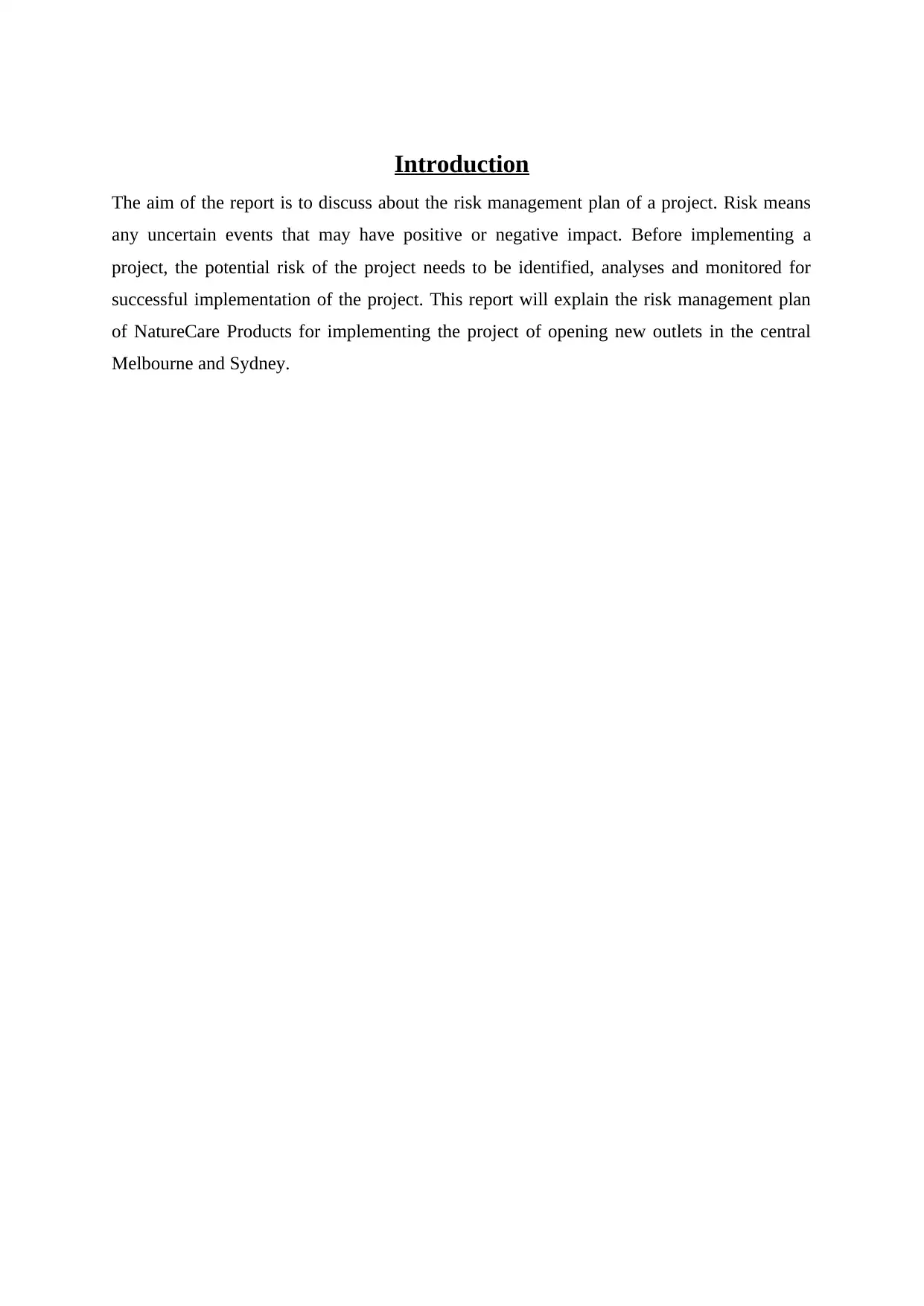
Introduction
The aim of the report is to discuss about the risk management plan of a project. Risk means
any uncertain events that may have positive or negative impact. Before implementing a
project, the potential risk of the project needs to be identified, analyses and monitored for
successful implementation of the project. This report will explain the risk management plan
of NatureCare Products for implementing the project of opening new outlets in the central
Melbourne and Sydney.
The aim of the report is to discuss about the risk management plan of a project. Risk means
any uncertain events that may have positive or negative impact. Before implementing a
project, the potential risk of the project needs to be identified, analyses and monitored for
successful implementation of the project. This report will explain the risk management plan
of NatureCare Products for implementing the project of opening new outlets in the central
Melbourne and Sydney.
⊘ This is a preview!⊘
Do you want full access?
Subscribe today to unlock all pages.

Trusted by 1+ million students worldwide
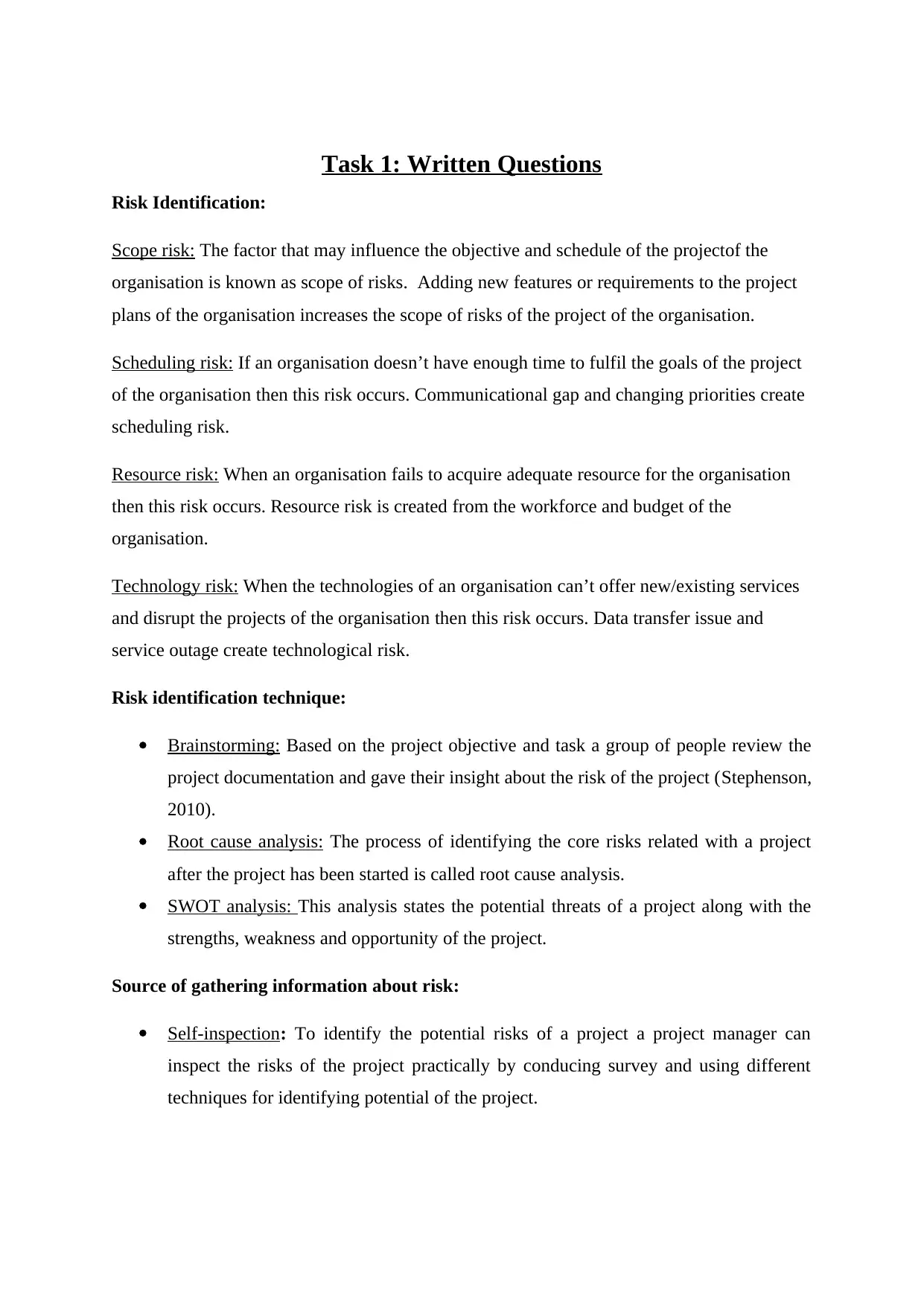
Task 1: Written Questions
Risk Identification:
Scope risk: The factor that may influence the objective and schedule of the projectof the
organisation is known as scope of risks. Adding new features or requirements to the project
plans of the organisation increases the scope of risks of the project of the organisation.
Scheduling risk: If an organisation doesn’t have enough time to fulfil the goals of the project
of the organisation then this risk occurs. Communicational gap and changing priorities create
scheduling risk.
Resource risk: When an organisation fails to acquire adequate resource for the organisation
then this risk occurs. Resource risk is created from the workforce and budget of the
organisation.
Technology risk: When the technologies of an organisation can’t offer new/existing services
and disrupt the projects of the organisation then this risk occurs. Data transfer issue and
service outage create technological risk.
Risk identification technique:
Brainstorming: Based on the project objective and task a group of people review the
project documentation and gave their insight about the risk of the project (Stephenson,
2010).
Root cause analysis: The process of identifying the core risks related with a project
after the project has been started is called root cause analysis.
SWOT analysis: This analysis states the potential threats of a project along with the
strengths, weakness and opportunity of the project.
Source of gathering information about risk:
Self-inspection: To identify the potential risks of a project a project manager can
inspect the risks of the project practically by conducing survey and using different
techniques for identifying potential of the project.
Risk Identification:
Scope risk: The factor that may influence the objective and schedule of the projectof the
organisation is known as scope of risks. Adding new features or requirements to the project
plans of the organisation increases the scope of risks of the project of the organisation.
Scheduling risk: If an organisation doesn’t have enough time to fulfil the goals of the project
of the organisation then this risk occurs. Communicational gap and changing priorities create
scheduling risk.
Resource risk: When an organisation fails to acquire adequate resource for the organisation
then this risk occurs. Resource risk is created from the workforce and budget of the
organisation.
Technology risk: When the technologies of an organisation can’t offer new/existing services
and disrupt the projects of the organisation then this risk occurs. Data transfer issue and
service outage create technological risk.
Risk identification technique:
Brainstorming: Based on the project objective and task a group of people review the
project documentation and gave their insight about the risk of the project (Stephenson,
2010).
Root cause analysis: The process of identifying the core risks related with a project
after the project has been started is called root cause analysis.
SWOT analysis: This analysis states the potential threats of a project along with the
strengths, weakness and opportunity of the project.
Source of gathering information about risk:
Self-inspection: To identify the potential risks of a project a project manager can
inspect the risks of the project practically by conducing survey and using different
techniques for identifying potential of the project.
Paraphrase This Document
Need a fresh take? Get an instant paraphrase of this document with our AI Paraphraser
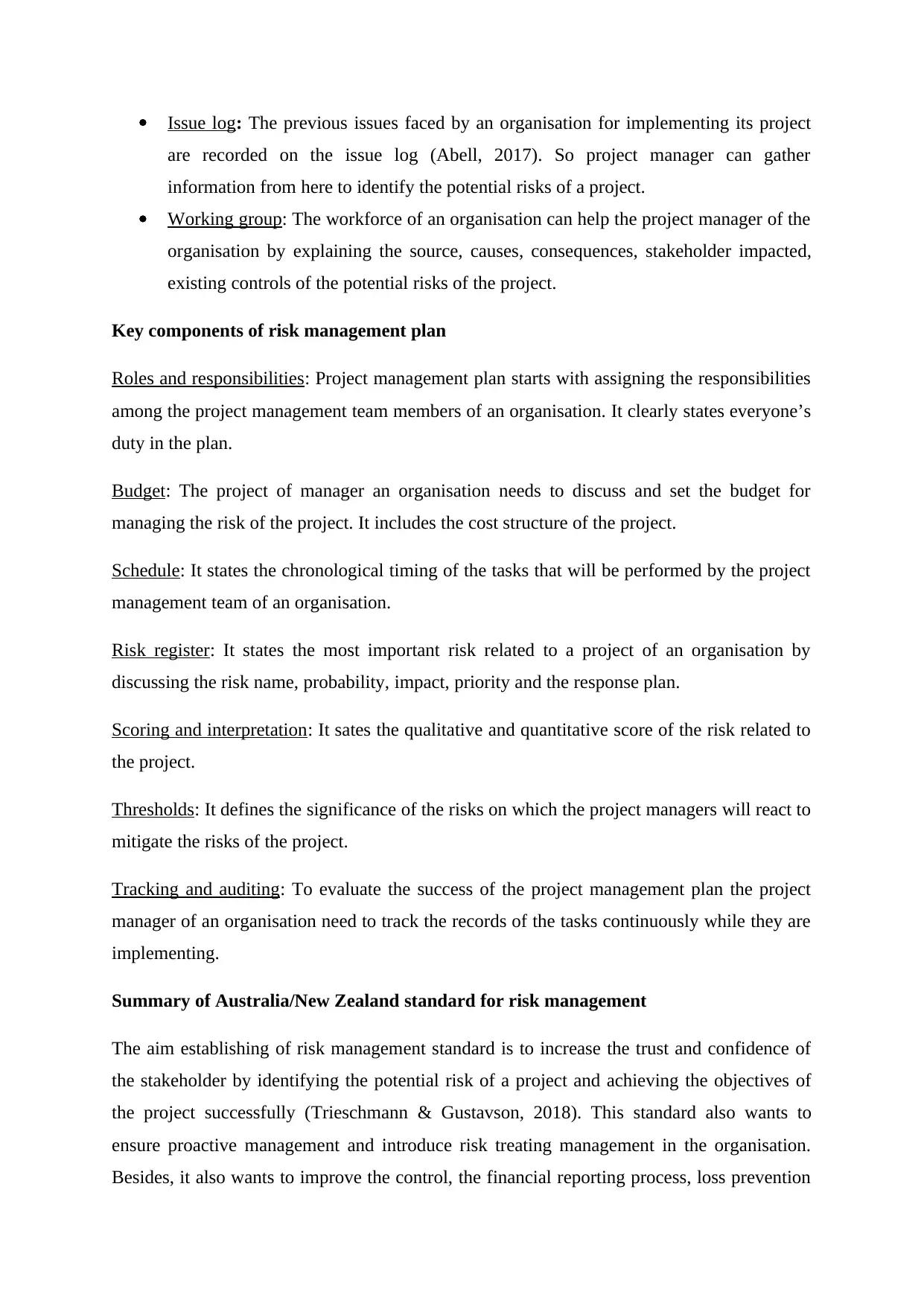
Issue log: The previous issues faced by an organisation for implementing its project
are recorded on the issue log (Abell, 2017). So project manager can gather
information from here to identify the potential risks of a project.
Working group: The workforce of an organisation can help the project manager of the
organisation by explaining the source, causes, consequences, stakeholder impacted,
existing controls of the potential risks of the project.
Key components of risk management plan
Roles and responsibilities: Project management plan starts with assigning the responsibilities
among the project management team members of an organisation. It clearly states everyone’s
duty in the plan.
Budget: The project of manager an organisation needs to discuss and set the budget for
managing the risk of the project. It includes the cost structure of the project.
Schedule: It states the chronological timing of the tasks that will be performed by the project
management team of an organisation.
Risk register: It states the most important risk related to a project of an organisation by
discussing the risk name, probability, impact, priority and the response plan.
Scoring and interpretation: It sates the qualitative and quantitative score of the risk related to
the project.
Thresholds: It defines the significance of the risks on which the project managers will react to
mitigate the risks of the project.
Tracking and auditing: To evaluate the success of the project management plan the project
manager of an organisation need to track the records of the tasks continuously while they are
implementing.
Summary of Australia/New Zealand standard for risk management
The aim establishing of risk management standard is to increase the trust and confidence of
the stakeholder by identifying the potential risk of a project and achieving the objectives of
the project successfully (Trieschmann & Gustavson, 2018). This standard also wants to
ensure proactive management and introduce risk treating management in the organisation.
Besides, it also wants to improve the control, the financial reporting process, loss prevention
are recorded on the issue log (Abell, 2017). So project manager can gather
information from here to identify the potential risks of a project.
Working group: The workforce of an organisation can help the project manager of the
organisation by explaining the source, causes, consequences, stakeholder impacted,
existing controls of the potential risks of the project.
Key components of risk management plan
Roles and responsibilities: Project management plan starts with assigning the responsibilities
among the project management team members of an organisation. It clearly states everyone’s
duty in the plan.
Budget: The project of manager an organisation needs to discuss and set the budget for
managing the risk of the project. It includes the cost structure of the project.
Schedule: It states the chronological timing of the tasks that will be performed by the project
management team of an organisation.
Risk register: It states the most important risk related to a project of an organisation by
discussing the risk name, probability, impact, priority and the response plan.
Scoring and interpretation: It sates the qualitative and quantitative score of the risk related to
the project.
Thresholds: It defines the significance of the risks on which the project managers will react to
mitigate the risks of the project.
Tracking and auditing: To evaluate the success of the project management plan the project
manager of an organisation need to track the records of the tasks continuously while they are
implementing.
Summary of Australia/New Zealand standard for risk management
The aim establishing of risk management standard is to increase the trust and confidence of
the stakeholder by identifying the potential risk of a project and achieving the objectives of
the project successfully (Trieschmann & Gustavson, 2018). This standard also wants to
ensure proactive management and introduce risk treating management in the organisation.
Besides, it also wants to improve the control, the financial reporting process, loss prevention
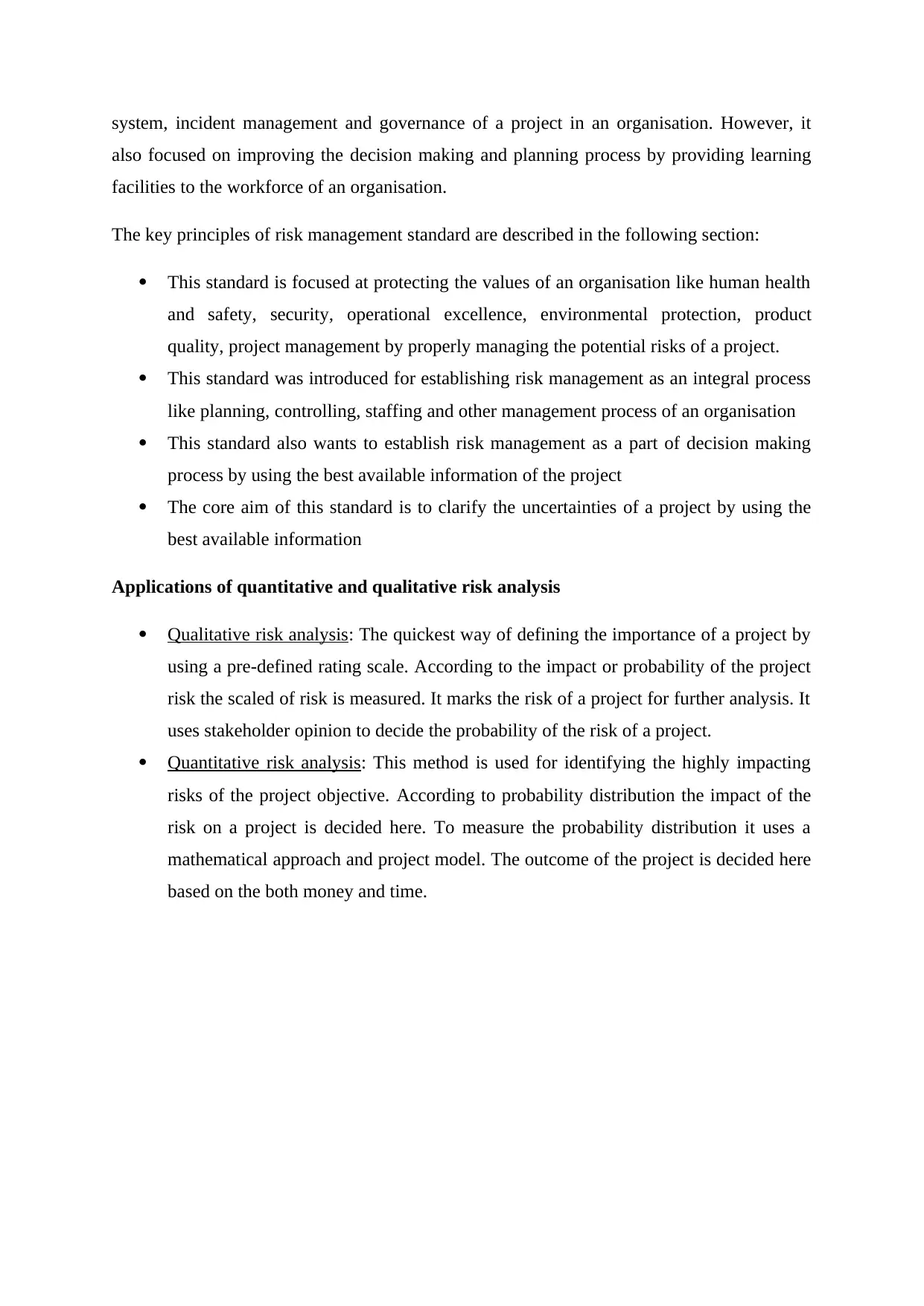
system, incident management and governance of a project in an organisation. However, it
also focused on improving the decision making and planning process by providing learning
facilities to the workforce of an organisation.
The key principles of risk management standard are described in the following section:
This standard is focused at protecting the values of an organisation like human health
and safety, security, operational excellence, environmental protection, product
quality, project management by properly managing the potential risks of a project.
This standard was introduced for establishing risk management as an integral process
like planning, controlling, staffing and other management process of an organisation
This standard also wants to establish risk management as a part of decision making
process by using the best available information of the project
The core aim of this standard is to clarify the uncertainties of a project by using the
best available information
Applications of quantitative and qualitative risk analysis
Qualitative risk analysis: The quickest way of defining the importance of a project by
using a pre-defined rating scale. According to the impact or probability of the project
risk the scaled of risk is measured. It marks the risk of a project for further analysis. It
uses stakeholder opinion to decide the probability of the risk of a project.
Quantitative risk analysis: This method is used for identifying the highly impacting
risks of the project objective. According to probability distribution the impact of the
risk on a project is decided here. To measure the probability distribution it uses a
mathematical approach and project model. The outcome of the project is decided here
based on the both money and time.
also focused on improving the decision making and planning process by providing learning
facilities to the workforce of an organisation.
The key principles of risk management standard are described in the following section:
This standard is focused at protecting the values of an organisation like human health
and safety, security, operational excellence, environmental protection, product
quality, project management by properly managing the potential risks of a project.
This standard was introduced for establishing risk management as an integral process
like planning, controlling, staffing and other management process of an organisation
This standard also wants to establish risk management as a part of decision making
process by using the best available information of the project
The core aim of this standard is to clarify the uncertainties of a project by using the
best available information
Applications of quantitative and qualitative risk analysis
Qualitative risk analysis: The quickest way of defining the importance of a project by
using a pre-defined rating scale. According to the impact or probability of the project
risk the scaled of risk is measured. It marks the risk of a project for further analysis. It
uses stakeholder opinion to decide the probability of the risk of a project.
Quantitative risk analysis: This method is used for identifying the highly impacting
risks of the project objective. According to probability distribution the impact of the
risk on a project is decided here. To measure the probability distribution it uses a
mathematical approach and project model. The outcome of the project is decided here
based on the both money and time.
⊘ This is a preview!⊘
Do you want full access?
Subscribe today to unlock all pages.

Trusted by 1+ million students worldwide
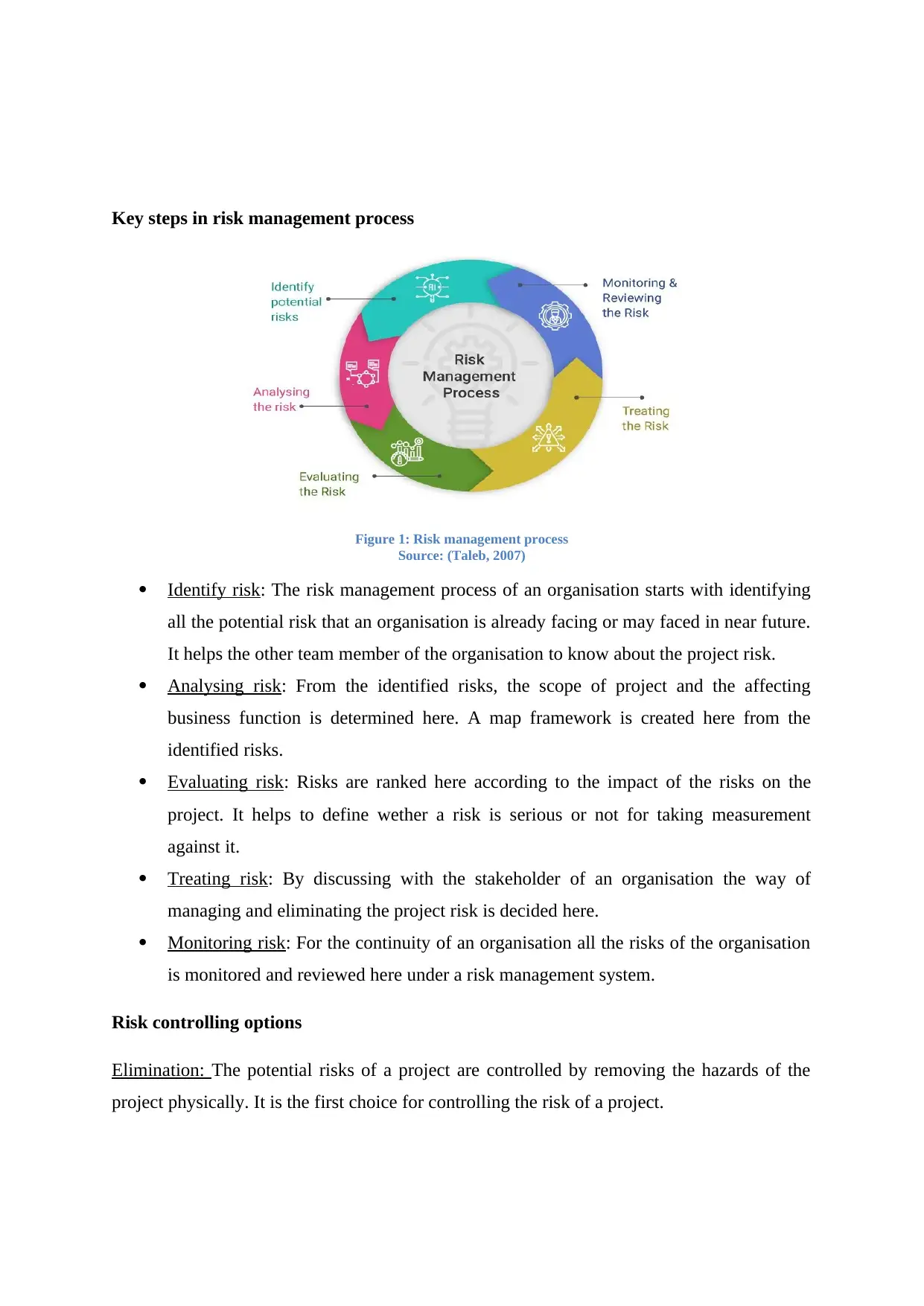
Key steps in risk management process
Figure 1: Risk management process
Source: (Taleb, 2007)
Identify risk: The risk management process of an organisation starts with identifying
all the potential risk that an organisation is already facing or may faced in near future.
It helps the other team member of the organisation to know about the project risk.
Analysing risk: From the identified risks, the scope of project and the affecting
business function is determined here. A map framework is created here from the
identified risks.
Evaluating risk: Risks are ranked here according to the impact of the risks on the
project. It helps to define wether a risk is serious or not for taking measurement
against it.
Treating risk: By discussing with the stakeholder of an organisation the way of
managing and eliminating the project risk is decided here.
Monitoring risk: For the continuity of an organisation all the risks of the organisation
is monitored and reviewed here under a risk management system.
Risk controlling options
Elimination: The potential risks of a project are controlled by removing the hazards of the
project physically. It is the first choice for controlling the risk of a project.
Figure 1: Risk management process
Source: (Taleb, 2007)
Identify risk: The risk management process of an organisation starts with identifying
all the potential risk that an organisation is already facing or may faced in near future.
It helps the other team member of the organisation to know about the project risk.
Analysing risk: From the identified risks, the scope of project and the affecting
business function is determined here. A map framework is created here from the
identified risks.
Evaluating risk: Risks are ranked here according to the impact of the risks on the
project. It helps to define wether a risk is serious or not for taking measurement
against it.
Treating risk: By discussing with the stakeholder of an organisation the way of
managing and eliminating the project risk is decided here.
Monitoring risk: For the continuity of an organisation all the risks of the organisation
is monitored and reviewed here under a risk management system.
Risk controlling options
Elimination: The potential risks of a project are controlled by removing the hazards of the
project physically. It is the first choice for controlling the risk of a project.
Paraphrase This Document
Need a fresh take? Get an instant paraphrase of this document with our AI Paraphraser
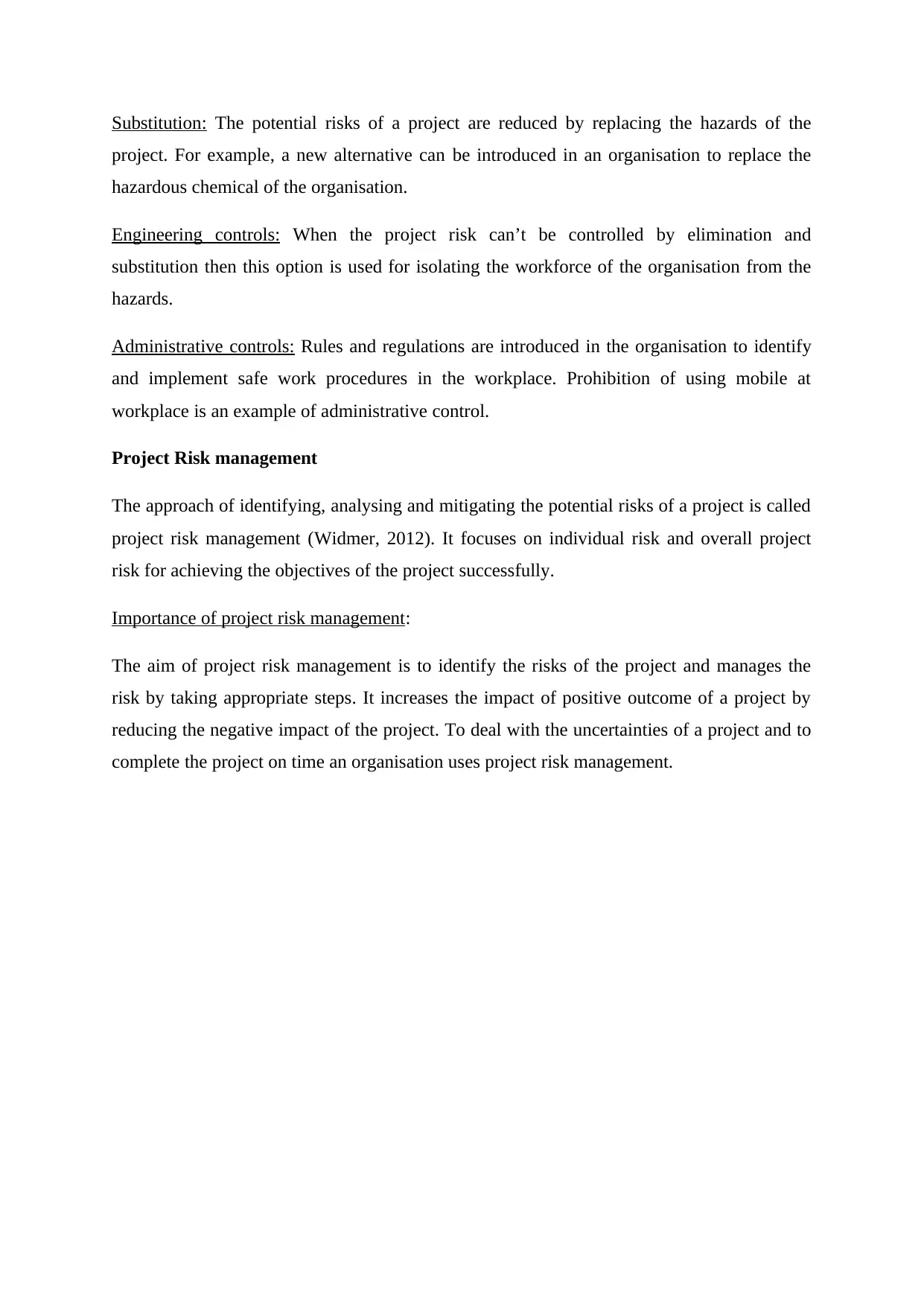
Substitution: The potential risks of a project are reduced by replacing the hazards of the
project. For example, a new alternative can be introduced in an organisation to replace the
hazardous chemical of the organisation.
Engineering controls: When the project risk can’t be controlled by elimination and
substitution then this option is used for isolating the workforce of the organisation from the
hazards.
Administrative controls: Rules and regulations are introduced in the organisation to identify
and implement safe work procedures in the workplace. Prohibition of using mobile at
workplace is an example of administrative control.
Project Risk management
The approach of identifying, analysing and mitigating the potential risks of a project is called
project risk management (Widmer, 2012). It focuses on individual risk and overall project
risk for achieving the objectives of the project successfully.
Importance of project risk management:
The aim of project risk management is to identify the risks of the project and manages the
risk by taking appropriate steps. It increases the impact of positive outcome of a project by
reducing the negative impact of the project. To deal with the uncertainties of a project and to
complete the project on time an organisation uses project risk management.
project. For example, a new alternative can be introduced in an organisation to replace the
hazardous chemical of the organisation.
Engineering controls: When the project risk can’t be controlled by elimination and
substitution then this option is used for isolating the workforce of the organisation from the
hazards.
Administrative controls: Rules and regulations are introduced in the organisation to identify
and implement safe work procedures in the workplace. Prohibition of using mobile at
workplace is an example of administrative control.
Project Risk management
The approach of identifying, analysing and mitigating the potential risks of a project is called
project risk management (Widmer, 2012). It focuses on individual risk and overall project
risk for achieving the objectives of the project successfully.
Importance of project risk management:
The aim of project risk management is to identify the risks of the project and manages the
risk by taking appropriate steps. It increases the impact of positive outcome of a project by
reducing the negative impact of the project. To deal with the uncertainties of a project and to
complete the project on time an organisation uses project risk management.
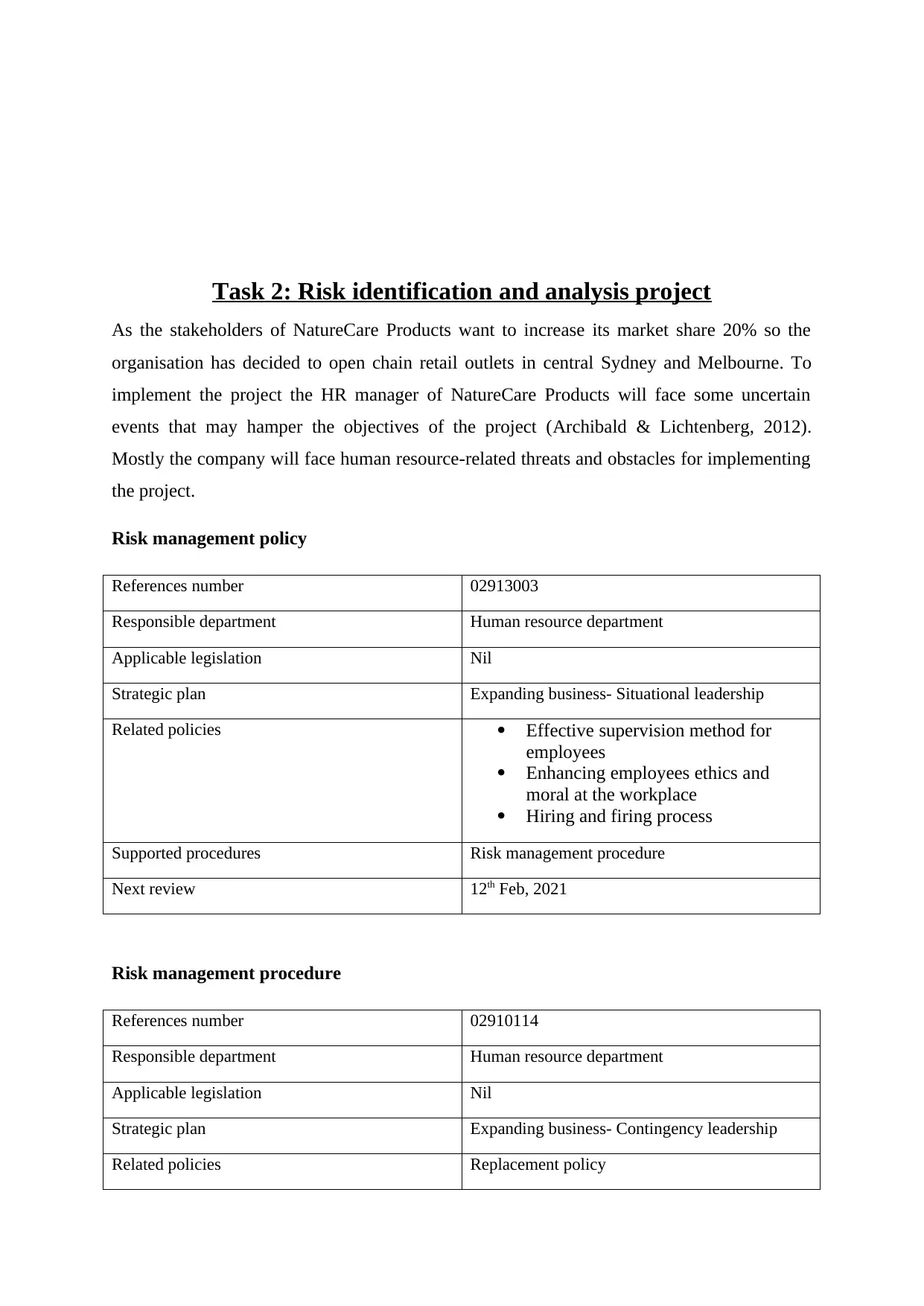
Task 2: Risk identification and analysis project
As the stakeholders of NatureCare Products want to increase its market share 20% so the
organisation has decided to open chain retail outlets in central Sydney and Melbourne. To
implement the project the HR manager of NatureCare Products will face some uncertain
events that may hamper the objectives of the project (Archibald & Lichtenberg, 2012).
Mostly the company will face human resource-related threats and obstacles for implementing
the project.
Risk management policy
References number 02913003
Responsible department Human resource department
Applicable legislation Nil
Strategic plan Expanding business- Situational leadership
Related policies Effective supervision method for
employees
Enhancing employees ethics and
moral at the workplace
Hiring and firing process
Supported procedures Risk management procedure
Next review 12th Feb, 2021
Risk management procedure
References number 02910114
Responsible department Human resource department
Applicable legislation Nil
Strategic plan Expanding business- Contingency leadership
Related policies Replacement policy
As the stakeholders of NatureCare Products want to increase its market share 20% so the
organisation has decided to open chain retail outlets in central Sydney and Melbourne. To
implement the project the HR manager of NatureCare Products will face some uncertain
events that may hamper the objectives of the project (Archibald & Lichtenberg, 2012).
Mostly the company will face human resource-related threats and obstacles for implementing
the project.
Risk management policy
References number 02913003
Responsible department Human resource department
Applicable legislation Nil
Strategic plan Expanding business- Situational leadership
Related policies Effective supervision method for
employees
Enhancing employees ethics and
moral at the workplace
Hiring and firing process
Supported procedures Risk management procedure
Next review 12th Feb, 2021
Risk management procedure
References number 02910114
Responsible department Human resource department
Applicable legislation Nil
Strategic plan Expanding business- Contingency leadership
Related policies Replacement policy
⊘ This is a preview!⊘
Do you want full access?
Subscribe today to unlock all pages.

Trusted by 1+ million students worldwide
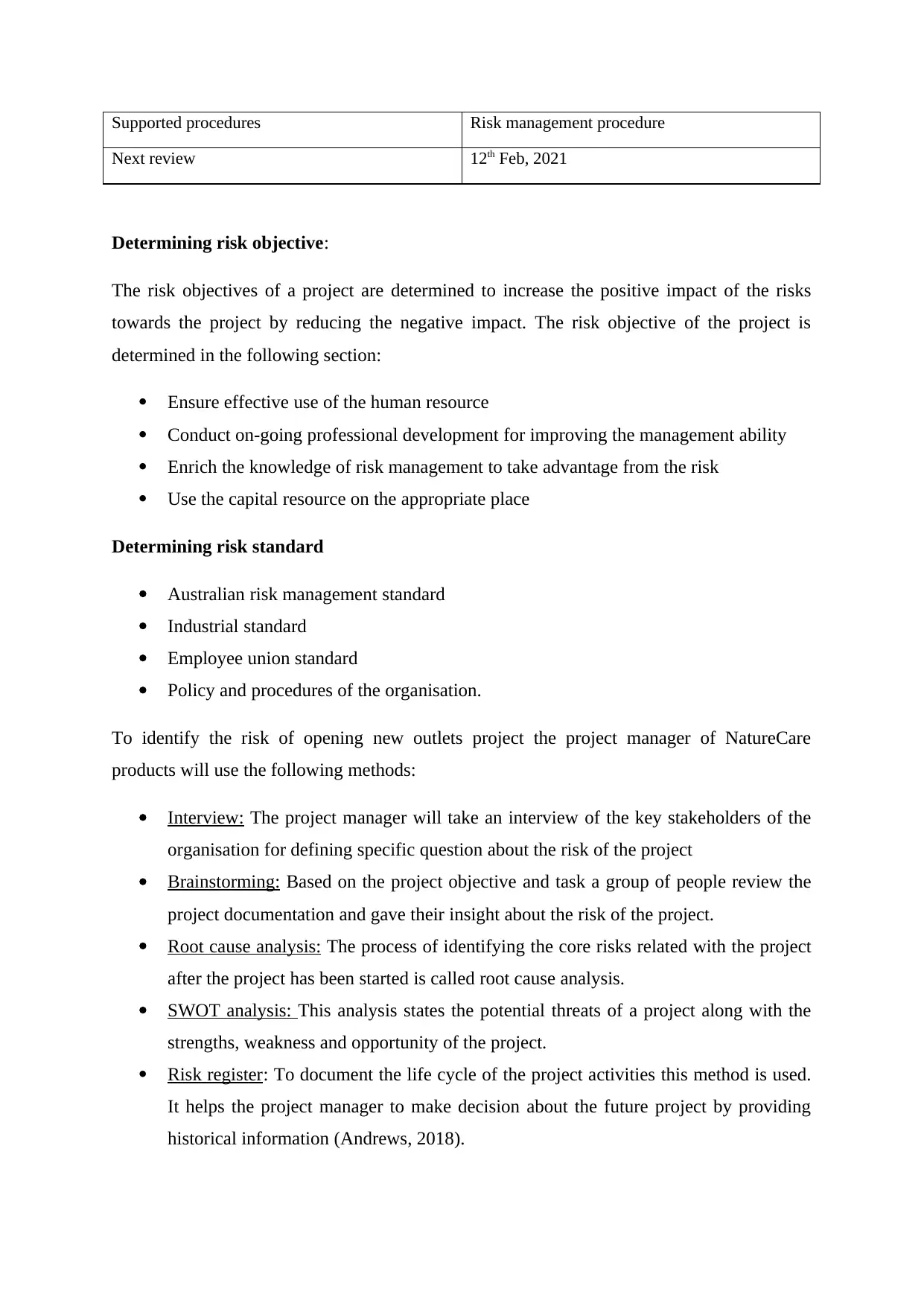
Supported procedures Risk management procedure
Next review 12th Feb, 2021
Determining risk objective:
The risk objectives of a project are determined to increase the positive impact of the risks
towards the project by reducing the negative impact. The risk objective of the project is
determined in the following section:
Ensure effective use of the human resource
Conduct on-going professional development for improving the management ability
Enrich the knowledge of risk management to take advantage from the risk
Use the capital resource on the appropriate place
Determining risk standard
Australian risk management standard
Industrial standard
Employee union standard
Policy and procedures of the organisation.
To identify the risk of opening new outlets project the project manager of NatureCare
products will use the following methods:
Interview: The project manager will take an interview of the key stakeholders of the
organisation for defining specific question about the risk of the project
Brainstorming: Based on the project objective and task a group of people review the
project documentation and gave their insight about the risk of the project.
Root cause analysis: The process of identifying the core risks related with the project
after the project has been started is called root cause analysis.
SWOT analysis: This analysis states the potential threats of a project along with the
strengths, weakness and opportunity of the project.
Risk register: To document the life cycle of the project activities this method is used.
It helps the project manager to make decision about the future project by providing
historical information (Andrews, 2018).
Next review 12th Feb, 2021
Determining risk objective:
The risk objectives of a project are determined to increase the positive impact of the risks
towards the project by reducing the negative impact. The risk objective of the project is
determined in the following section:
Ensure effective use of the human resource
Conduct on-going professional development for improving the management ability
Enrich the knowledge of risk management to take advantage from the risk
Use the capital resource on the appropriate place
Determining risk standard
Australian risk management standard
Industrial standard
Employee union standard
Policy and procedures of the organisation.
To identify the risk of opening new outlets project the project manager of NatureCare
products will use the following methods:
Interview: The project manager will take an interview of the key stakeholders of the
organisation for defining specific question about the risk of the project
Brainstorming: Based on the project objective and task a group of people review the
project documentation and gave their insight about the risk of the project.
Root cause analysis: The process of identifying the core risks related with the project
after the project has been started is called root cause analysis.
SWOT analysis: This analysis states the potential threats of a project along with the
strengths, weakness and opportunity of the project.
Risk register: To document the life cycle of the project activities this method is used.
It helps the project manager to make decision about the future project by providing
historical information (Andrews, 2018).
Paraphrase This Document
Need a fresh take? Get an instant paraphrase of this document with our AI Paraphraser
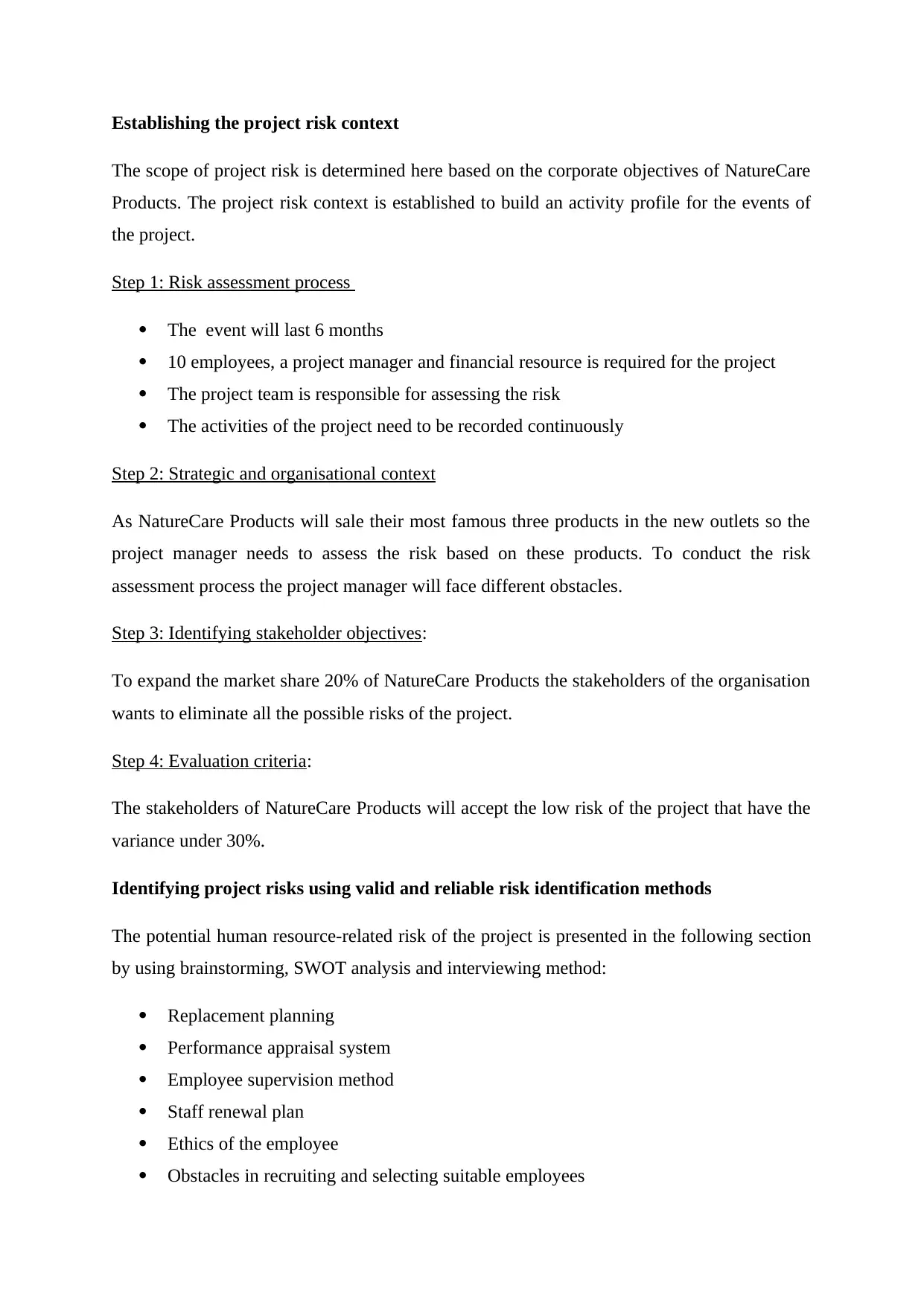
Establishing the project risk context
The scope of project risk is determined here based on the corporate objectives of NatureCare
Products. The project risk context is established to build an activity profile for the events of
the project.
Step 1: Risk assessment process
The event will last 6 months
10 employees, a project manager and financial resource is required for the project
The project team is responsible for assessing the risk
The activities of the project need to be recorded continuously
Step 2: Strategic and organisational context
As NatureCare Products will sale their most famous three products in the new outlets so the
project manager needs to assess the risk based on these products. To conduct the risk
assessment process the project manager will face different obstacles.
Step 3: Identifying stakeholder objectives:
To expand the market share 20% of NatureCare Products the stakeholders of the organisation
wants to eliminate all the possible risks of the project.
Step 4: Evaluation criteria:
The stakeholders of NatureCare Products will accept the low risk of the project that have the
variance under 30%.
Identifying project risks using valid and reliable risk identification methods
The potential human resource-related risk of the project is presented in the following section
by using brainstorming, SWOT analysis and interviewing method:
Replacement planning
Performance appraisal system
Employee supervision method
Staff renewal plan
Ethics of the employee
Obstacles in recruiting and selecting suitable employees
The scope of project risk is determined here based on the corporate objectives of NatureCare
Products. The project risk context is established to build an activity profile for the events of
the project.
Step 1: Risk assessment process
The event will last 6 months
10 employees, a project manager and financial resource is required for the project
The project team is responsible for assessing the risk
The activities of the project need to be recorded continuously
Step 2: Strategic and organisational context
As NatureCare Products will sale their most famous three products in the new outlets so the
project manager needs to assess the risk based on these products. To conduct the risk
assessment process the project manager will face different obstacles.
Step 3: Identifying stakeholder objectives:
To expand the market share 20% of NatureCare Products the stakeholders of the organisation
wants to eliminate all the possible risks of the project.
Step 4: Evaluation criteria:
The stakeholders of NatureCare Products will accept the low risk of the project that have the
variance under 30%.
Identifying project risks using valid and reliable risk identification methods
The potential human resource-related risk of the project is presented in the following section
by using brainstorming, SWOT analysis and interviewing method:
Replacement planning
Performance appraisal system
Employee supervision method
Staff renewal plan
Ethics of the employee
Obstacles in recruiting and selecting suitable employees
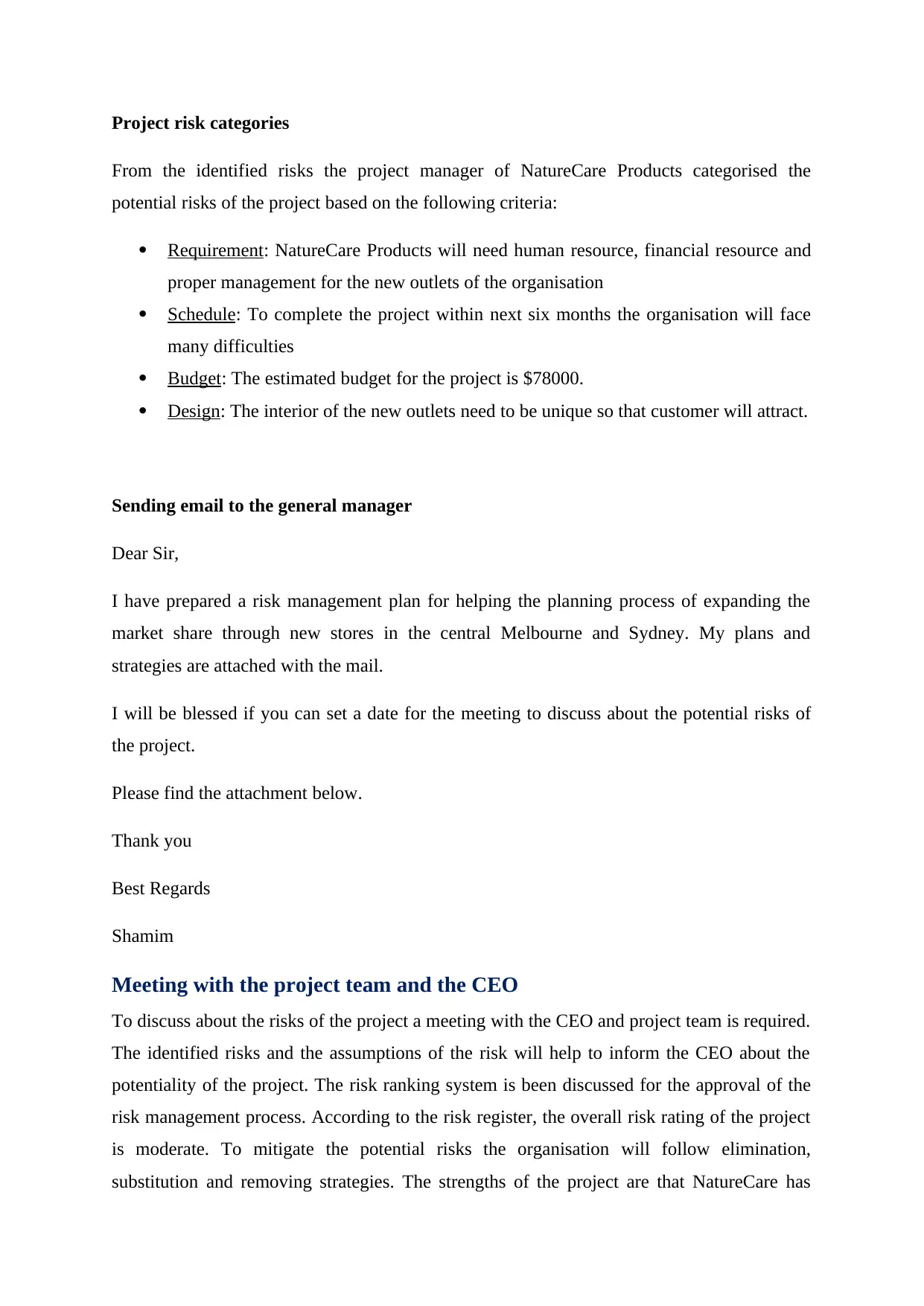
Project risk categories
From the identified risks the project manager of NatureCare Products categorised the
potential risks of the project based on the following criteria:
Requirement: NatureCare Products will need human resource, financial resource and
proper management for the new outlets of the organisation
Schedule: To complete the project within next six months the organisation will face
many difficulties
Budget: The estimated budget for the project is $78000.
Design: The interior of the new outlets need to be unique so that customer will attract.
Sending email to the general manager
Dear Sir,
I have prepared a risk management plan for helping the planning process of expanding the
market share through new stores in the central Melbourne and Sydney. My plans and
strategies are attached with the mail.
I will be blessed if you can set a date for the meeting to discuss about the potential risks of
the project.
Please find the attachment below.
Thank you
Best Regards
Shamim
Meeting with the project team and the CEO
To discuss about the risks of the project a meeting with the CEO and project team is required.
The identified risks and the assumptions of the risk will help to inform the CEO about the
potentiality of the project. The risk ranking system is been discussed for the approval of the
risk management process. According to the risk register, the overall risk rating of the project
is moderate. To mitigate the potential risks the organisation will follow elimination,
substitution and removing strategies. The strengths of the project are that NatureCare has
From the identified risks the project manager of NatureCare Products categorised the
potential risks of the project based on the following criteria:
Requirement: NatureCare Products will need human resource, financial resource and
proper management for the new outlets of the organisation
Schedule: To complete the project within next six months the organisation will face
many difficulties
Budget: The estimated budget for the project is $78000.
Design: The interior of the new outlets need to be unique so that customer will attract.
Sending email to the general manager
Dear Sir,
I have prepared a risk management plan for helping the planning process of expanding the
market share through new stores in the central Melbourne and Sydney. My plans and
strategies are attached with the mail.
I will be blessed if you can set a date for the meeting to discuss about the potential risks of
the project.
Please find the attachment below.
Thank you
Best Regards
Shamim
Meeting with the project team and the CEO
To discuss about the risks of the project a meeting with the CEO and project team is required.
The identified risks and the assumptions of the risk will help to inform the CEO about the
potentiality of the project. The risk ranking system is been discussed for the approval of the
risk management process. According to the risk register, the overall risk rating of the project
is moderate. To mitigate the potential risks the organisation will follow elimination,
substitution and removing strategies. The strengths of the project are that NatureCare has
⊘ This is a preview!⊘
Do you want full access?
Subscribe today to unlock all pages.

Trusted by 1+ million students worldwide
1 out of 21
Related Documents
Your All-in-One AI-Powered Toolkit for Academic Success.
+13062052269
info@desklib.com
Available 24*7 on WhatsApp / Email
![[object Object]](/_next/static/media/star-bottom.7253800d.svg)
Unlock your academic potential
Copyright © 2020–2025 A2Z Services. All Rights Reserved. Developed and managed by ZUCOL.





